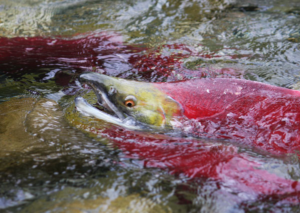The Okanagan River and its tributary streams are important spawning and rearing habitat for salmon and trout (salmonids) and other aquatic life. Fish and wildlife habitat in many sub-basins has been degraded or eliminated over the last century by water extraction, flood control structures, and by development of land next to watercourses. Protecting instream flows preserves environmental health and services (such as the ability of systems to naturally clean polluted water) for future generations, and also protects aboriginal rights to hunt and fish. Okanagan salmonids support important recreational and food fisheries in both Canada and the United States.
Instream flows are especially important because salmon and trout are sensitive to water quality and quantity. Compared to streams on the Pacific coast, many Okanagan streams do not naturally provide optimal habitat for fish like kokanee that thrive in cold water. This desk-based (not field) Study estimated the minimum risk and optimal instream flow needs for fish and the ecosystems they rely on. The Study gathered data on where sensitive species occur, and how their life-cycle water needs (for example, spawning conditions) are affected by seasonal variations in water availability in different tributaries, lakes and rivers.
The Study found that the greatest challenges for fish spawning and rearing occur during low flow periods of the late summer to mid-winter. Other sensitive plants and animals were also identified as potentially impacted by variable instream flow or lake levels. However, it was noted that flow alone does not ensure the maintenance of water quality or required water temperatures.
While site-specific studies will yield the best estimates of instream flow needs for specific aquatic species, the pace of water allocation decisions requires a method of rapid assessment while site-specific field studies are conducted. Field assessments can verify instream flow needs to maintain important features like pools and riffles that provide essential fish habitat. Field studies can also develop more accurate estimates of the environmental flow regimes needed to sustain aquatic life and ecosystem function in any particular location (for example, scouring flows to clean gravel spawning beds).
As site-specific studies are expensive and time consuming (and must be performed over multiple years to determine environmental flow regime needs) fisheries biologists and planners can use this Study as a starting point to establish preliminary instream flow needs and priority areas to target for future site-specific research.
As described in the report, three types of science based instream flow guidelines were calculated for the Water Supply and Demand project:
- Conservative minimum risk flows specify the levels that are expected to result in low risk and stress to fish, fish habitat, and overall productive capacity of a stream; and that help to maintain important features of the natural hydrograph. Some natural and regulated streams in the Okanagan already have flow regimes that are stressful to fish. Minimum risk guidelines place the burden on water extraction proponents to prove there are no unacceptable consequences of such activities. The methods used to derive minimum risk flows was also used to define watershed conservation flows to sustain the geomorphic and riparian habitat conditions in and around streams.
- Optimal spawning and rearing flows were identified for kokanee, sockeye, rainbow trout, steelhead, chinook and coho in 36 Okanagan tributaries. These flows do not address all the needs of other fish or animals, or the quality of the habitat. While these three references identify some key instream flow needs, more detailed biological studies are required to protect additional species and their habitats. Some analysis of what is an acceptable level of risk is also needed.
- Flow guidelines from site specific studies / water use agreement negotiations. These flows are available for the Okanagan River mainstem, Trout Creek and Mission Creek. The flows for Trout Creek and Mission Creek address goals for rainbow trout, kokanee or sockeye salmon, and were part of Water Use Planning negotiations convened by the Province.
Additional new desk-based methods for instream flows are under development, based on some of the hydrology modeling completed as part of the Water Supply & Demand project.
The choice of which method used to determine instream flows depends on: (i) legal requirements in both federal and provincial laws, (ii) ecological objectives such as maintaining species diversity; (iii) personal and community values placed on healthy streams, and (iv) the larger environmental management strategy for fish protection in the Okanagan.
For example, choosing to protect a number of healthy sub-basins as ecological reserves where water extraction is highly constrained, while allowing more intensive development elsewhere.
Project Downloads:
- Summary Report – Section 10.0 – Instream Flow Needs for the Okanagan (20Kb PDF)
- Okanagan Instream Flow Needs Assessment (ESSA 2009 – 9.4MB PDF)
Related Links:

